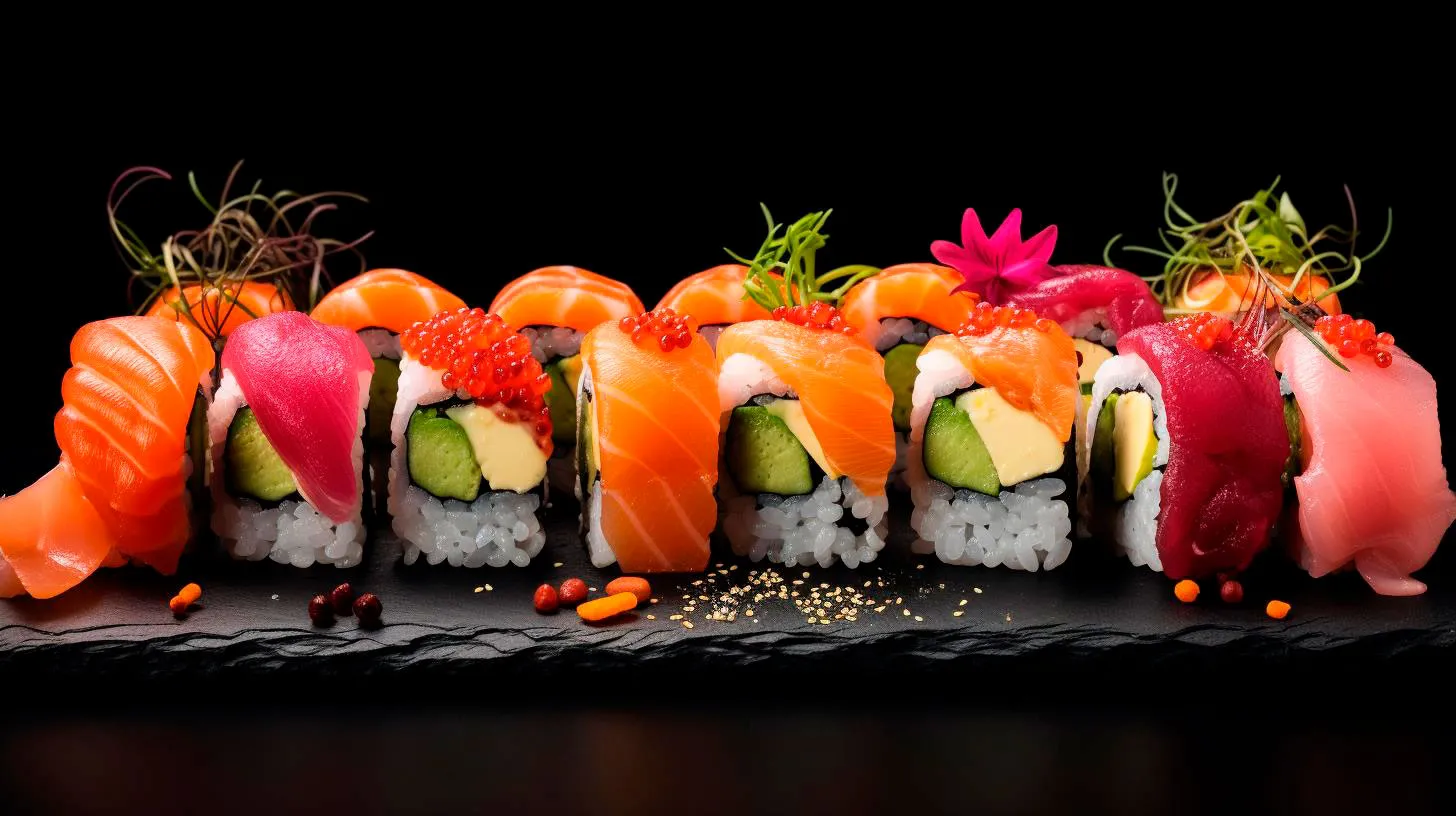From Farm to Table: The Sustainable Practices of Sushi Chefs
In this article, we will explore the journey that sushi takes from farm to table, the sustainable practices adopted by sushi chefs, and the benefits of these practices for both the environment and consumers.
Sustainable Sourcing of Ingredients
One of the most important aspects of sushi sustainability lies in the sourcing of ingredients. Sushi chefs are committed to procuring their ingredients in an ethical and environmentally responsible manner. Here are some sustainable sourcing practices implemented by sushi chefs:
- Supporting Local Fisheries: Sushi chefs prioritize sourcing fish and seafood from local fisheries. This reduces the environmental impact of transportation and supports the local economy.
- Seasonal Ingredients: Sushi chefs understand the importance of using ingredients that are in season. This reduces the need for artificial preservatives and ensures a fresher, better-tasting final product.
- Responsible Farming: Many sushi restaurants support responsible aquaculture practices by sourcing fish from sustainable fish farms. These farms prioritize the health and well-being of the fish, as well as the protection of the surrounding ecosystem.
Reducing Food Waste
Food waste is a major concern for the food industry, and sushi chefs are actively working to minimize wastage. Here are some ways in which sushi chefs are reducing food waste:
- Utilizing Whole Fish: Sushi chefs make use of every part of the fish, reducing waste and maximizing the yield. This not only reduces environmental impact but also ensures that the entire fish is utilized.
- Creative Menu Planning: Sushi chefs prioritize creating menus that make use of all available ingredients, resulting in a higher utilization rate and less food waste.
- Donation and Composting: Sushi restaurants often donate excess food to organizations in need or compost their food waste. These practices help to minimize the amount of food sent to landfills.
Promoting Sustainable Fishing Practices
Sushi chefs are passionate about protecting marine ecosystems and promoting sustainable fishing practices. Here’s how they contribute to the preservation of our oceans:
- Supporting Sustainable Certifications: Sushi chefs actively seek out suppliers who hold sustainable certifications, such as the Marine Stewardship Council (MSC) or the Aquaculture Stewardship Council (ASC). These certifications ensure that the seafood they source is caught or farmed using environmentally friendly methods.
- Advocating Responsible Fishing: Sushi chefs educate their customers about the importance of responsible fishing practices, such as avoiding endangered species and following catch limits. By informing consumers, sushi chefs contribute to the conservation of our marine resources.
- Choosing Alternative Ingredients: In response to overfishing concerns, sushi chefs are exploring alternative ingredients to traditional fish and seafood, such as plant-based options and sustainably farmed alternatives.
The Benefits for Consumers and the Environment
The sustainable practices embraced by sushi chefs benefit not only the environment but also consumers. Here are some of the advantages that arise from these practices:
- Higher Quality Sushi: By sourcing ingredients responsibly and using seasonal produce, sushi chefs ensure that the sushi they serve is of the highest quality, both in taste and freshness.
- Healthier Choices: Sustainable sourcing reduces the risk of consuming seafood contaminated with harmful substances such as mercury. Sushi chefs prioritize healthier options, ensuring that consumers make informed choices about what they consume.
- Supporting Local Communities: Sushi chefs’ preference for local sourcing contributes to the growth of local fisheries, ensuring the livelihood of fishermen and bolstering the local economy.
- Preserving Marine Ecosystems: By promoting sustainable fishing practices, sushi chefs actively contribute to the protection of marine ecosystems and the preservation of biodiversity.
Key Takeaways
The sustainable practices of sushi chefs play a crucial role in the sushi industry and have far-reaching benefits. To summarize, here are the key takeaways:
- Sushi chefs prioritize sustainable sourcing by supporting local fisheries and using seasonal ingredients.
- They reduce food waste by utilizing the whole fish and practicing creative menu planning.
- Sushi chefs promote sustainable fishing practices by supporting certifications and advocating responsible fishing.
- Consumers benefit from higher quality sushi, healthier choices, and support for local communities.
- The environment benefits from the preservation of marine ecosystems and biodiversity.
The next time you enjoy a delicious plate of sushi, take a moment to appreciate the sustainable practices that sushi chefs adopt. Their commitment to ethical sourcing and environmental responsibility ensures that your culinary experience is not only enjoyable but also contributes to a better and more sustainable future.
Pushing Boundaries: Seafood Sushi Chefs Pioneering Sustainable Solutions
These dedicated chefs are pushing boundaries to ensure that the future of seafood sushi remains not only delicious but also environmentally conscious. Let’s explore some of the remarkable initiatives they are undertaking.
Sourcing Locally and Responsibly
One of the key steps seafood sushi chefs are taking is sourcing their ingredients locally and responsibly. By partnering with local fishermen who practice sustainable fishing methods, these chefs are not only supporting their communities but also contributing to the conservation of marine life. This approach reduces the carbon footprint associated with long-distance transportation and helps maintain the delicate balance of our oceans.
Key Takeaway: Sourcing seafood locally and responsibly promotes sustainability, supports local economies, and ensures fresher and higher quality ingredients for sushi preparation.
Empowering Consumers with Knowledge
To further their commitment to sustainability, seafood sushi chefs are not only focused on what happens in their kitchens but also on educating their customers. They actively communicate the importance of responsible seafood consumption and encourage their patrons to make informed choices. By providing information about the sourcing, fishing methods, and sustainability practices, these chefs empower consumers to play an active role in the conservation efforts.
Key Takeaway: Educating consumers about sustainable seafood helps create a conscious consumer base that supports sustainable practices and contributes to the preservation of marine ecosystems.
Exploring Alternative Ingredients
Another exciting avenue that sushi chefs are exploring is the use of alternative ingredients in their creations. By incorporating plant-based options and sustainable alternatives to traditional seafood, they are reducing the reliance on overfished species and expanding the possibilities of sushi making. This approach not only diversifies the flavors but also introduces new textures and experiences for sushi enthusiasts.
Key Takeaway: Exploring alternative ingredients for sushi offers a wider range of flavors and textures, reduces pressure on overfished species, and encourages creative culinary expressions.
Thinking Outside the Box
Seafood sushi chefs are renowned for their creativity and ability to experiment with flavors. In their quest for sustainability, they are pushing the boundaries of traditional sushi by incorporating locally sourced produce, unique spices, and innovative cooking techniques. By infusing their creations with regional touches and exploring fusion cuisines, these chefs are not only offering a memorable dining experience but also showcasing the potential for sustainable cross-cultural collaborations.
Key Takeaway: Thinking outside the box in sushi creation fosters culinary innovation, promotes regional diversity, and supports sustainable collaborations in the food industry.
Collaborating for a Sustainable Future
No chef can bring about a sustainable seafood revolution alone. Collaboration is crucial, and seafood sushi chefs understand this better than anyone. They actively collaborate with fisheries, conservation organizations, and fellow chefs to develop best practices, share knowledge, and promote sustainable fishing methods. By working together and sharing their experiences, they are building a strong community dedicated to preserving our oceans for generations to come.
Key Takeaway: Collaboration among seafood sushi chefs, fisheries, and conservation organizations fosters a collective effort to push the boundaries of sustainability and ensures a brighter future for our oceans.
In Conclusion
Seafood sushi chefs are at the forefront of pushing boundaries and pioneering sustainable solutions. Sourcing locally and responsibly, empowering consumers with knowledge, exploring alternative ingredients, thinking outside the box, and collaborating with others are just a few of the steps they are taking to make a positive impact on our environment. By embracing these initiatives, we can support their efforts while indulging in the culinary delights of seafood sushi without compromising the health of our oceans.
Innovative Techniques Revolutionizing Seafood Sushi Creation
These new methods are transforming the way sushi is made, enhancing flavors, presentation, and even sustainability. In this article, we will discover some of the latest innovative techniques that are revolutionizing seafood sushi creation.
1. Sous Vide Techniques
One of the most significant advancements in sushi creation is the implementation of sous vide techniques. Traditionally, raw fish used in sushi is marinated briefly in vinegar or soy sauce before being placed on sushi rice. However, sous vide cooking allows for a more controlled and precise way to prepare the seafood. This technique involves placing the fish in vacuum-sealed bags and cooking it in a water bath at a precise temperature for an extended period. The result is perfectly cooked, tender, and flavorful fish.
- Advantages:
- Improved texture and taste of the fish.
- Enhanced food safety as sous vide cooking achieves precise internal temperatures.
- Consistent results every time.
- Key Takeaway:
- Advantages:
- Allows for creative experimentation with flavors and textures.
- Provides a visually captivating dining experience.
- Opens up new possibilities for inventive sushi creations.
- Key Takeaway:
- Advantages:
- Reduces overfishing and helps maintain fish populations.
- Supports environmentally friendly farming practices.
- Allows for the availability of sustainable seafood options for sushi lovers.
- Key Takeaway:
- Advantages:
- Enhances the overall dining experience by stimulating all senses.
- Creates social media-worthy moments, attracting more customers.
- Encourages chefs to showcase their artistic abilities.
- Key Takeaway:
- Sushi chefs are proactively addressing sustainability challenges in the industry.
- They source seafood responsibly and support sustainable aquaculture.
- Ocean-friendly seafood guides help them make informed choices.
- Sushi chefs are reducing plastic waste by adopting eco-friendly packaging.
- They promote plant-based alternatives to reduce the strain on marine ecosystems.
- Education is an essential part of their efforts, raising awareness among customers.
Implementing sous vide techniques in sushi creation ensures consistently flavorful, moist, and perfectly cooked seafood.
2. Molecular Gastronomy
Molecular gastronomy is another groundbreaking technique that is pushing the boundaries of sushi creation. This method combines science and culinary arts to create visually stunning and unique flavor profiles. By using techniques such as spherification, gels, and foams, chefs can create sushi with surprising textures and unexpected flavors.
Molecular gastronomy techniques bring innovation, excitement, and artistry to the world of sushi creation.
3. Sustainable Sourcing
With the growing concern for sustainability, the seafood industry has faced challenges in ensuring responsible sourcing. Innovative techniques are now being employed to address these issues in sushi creation. Chefs are embracing sustainable fish farming practices, such as aquaponics and vertical farming, to produce high-quality seafood without depleting natural resources.
Eco-conscious sushi creation ensures the preservation of our oceans while still indulging in the delights of this beloved cuisine.
4. Edible Artistry
Revolutionary techniques in sushi creation have elevated the presentation of this culinary art form to new heights. Chefs are now utilizing their creativity and skills to transform sushi into edible masterpieces. Intricate designs, vibrant colors, and carefully curated plating techniques enhance the visual appeal of each sushi creation.
Edible artistry in sushi creation adds an element of surprise and delight, making each bite a memorable experience.
The world of sushi creation is evolving, and these innovative techniques are pushing the boundaries of tradition. From sous vide cooking to molecular gastronomy, sustainability, and edible artistry, sushi is being transformed into a gastronomic marvel. By embracing these revolutionary techniques, sushi aficionados can experience new flavors, textures, and dining experiences like never before.
Environmental Stewardship: How Sushi Chefs are Tackling Sustainability
In recent years, sushi chefs have emerged as environmental stewards, taking proactive steps to tackle these issues head-on.
1. Sustainable Sourcing of Seafood
One of the key initiatives taken by sushi chefs is the implementation of sustainable sourcing practices for seafood. By carefully selecting suppliers that follow responsible fishing methods and support sustainable aquaculture, sushi chefs ensure that they only use seafood that is harvested or farmed without causing harm to the environment.
2. The Rise of Ocean-Friendly Seafood Guides
Sushi chefs are increasingly relying on ocean-friendly seafood guides to make informed choices about the seafood they use. These guides provide information on the environmental impact of different fish species, helping chefs select sustainable options. By avoiding overfished species and choosing alternatives, sushi chefs are playing a crucial role in protecting marine biodiversity.
3. Reducing Plastic Waste
Plastic waste is a significant concern in the sushi industry. Sushi chefs are now adopting various measures to minimize and manage plastic waste. Some are opting for biodegradable or reusable alternatives to traditional plastic packaging, while others are encouraging customers to bring their own containers. These efforts contribute to the overall reduction of plastic pollution and promote sustainable packaging practices.
4. Promoting Plant-Based Options
Recognizing the environmental impact of traditional sushi ingredients like tuna, sushi chefs are embracing plant-based alternatives. Incorporating ingredients like tofu, mushrooms, and avocado into sushi rolls expands the range of sustainable options available to diners. By promoting plant-based sushi, chefs are contributing to reducing the strain on marine ecosystems and promoting a more sustainable food culture.
5. Educating Customers about Sustainability
Education plays a vital role in creating a sustainable sushi culture. Sushi chefs are taking the initiative to educate their customers about the importance of sustainability in the industry. They explain the impact of overfishing, plastic pollution, and unsustainable practices, empowering diners to make informed choices. By raising awareness, sushi chefs inspire positive change among consumers.
Key Takeaways
By taking these sustainable steps, sushi chefs are leading the way towards creating a more environmentally conscious sushi industry. Their efforts contribute not only to the preservation of marine ecosystems but also to raising awareness among consumers. Sushi lovers can indulge in their favorite cuisine while knowing that their choices align with a greener and more sustainable future.


